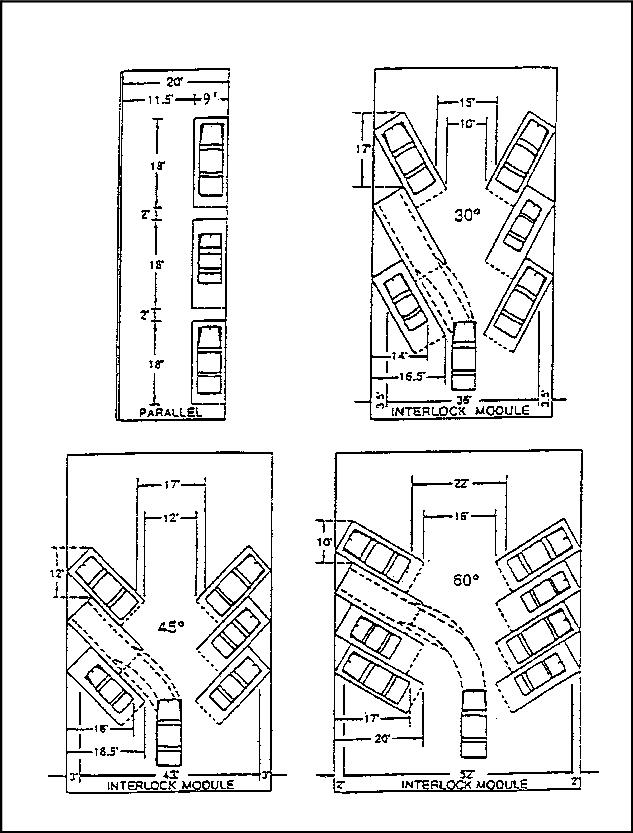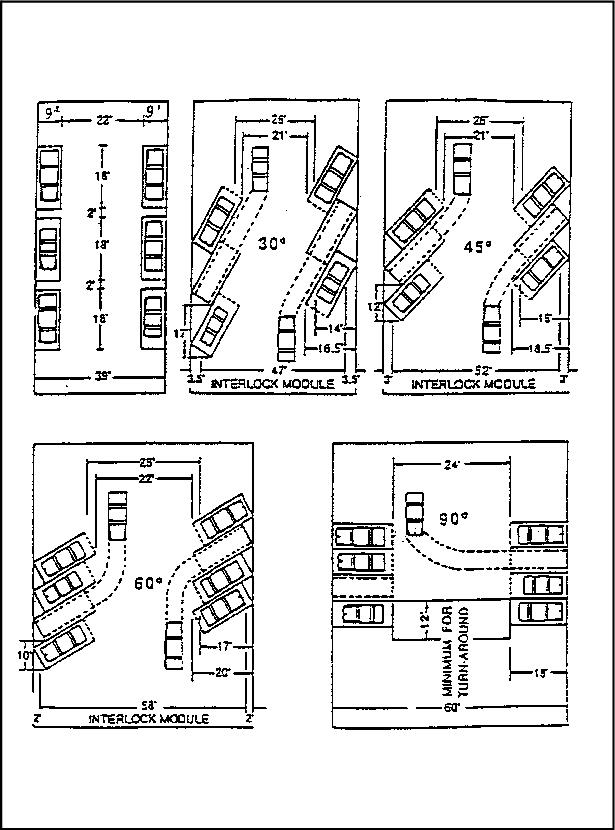Chapter 17.42
OFF-STREET PARKING AND LOADING
Sections:
17.42.030 Required off-street parking.
17.42.050 Off-site parking facilities.
17.42.060 Performance standards.
17.42.070 Development standards.
17.42.080 Reduction of off-street parking requirements.
17.42.090 Nonconforming parking.
17.42.010 Purpose.
It is the purpose of this chapter to provide adequate numbers of off-street parking spaces, vehicular ingress, egress and loading facilities in order to reduce on-street parking, increase traffic safety, maintain smooth traffic flow and reduce the visual impact of parking lots. (Ord. 07-093 § 1; Ord. 99-025 § 2).
17.42.020 Applicability.
A. Off-street parking and loading facilities shall be available prior to occupancy of a site, commencement of commercial/industrial activities, changes in use or major alteration/enlargement of the site, use or structure. All required parking spaces shall be permanently available and maintained for parking purposes only.
B. For the purposes of these requirements, “major alteration or enlargement” shall mean a change of use or an addition that would increase the number of parking spaces or loading berths required by this chapter by more than 10 percent of the total number required prior to the alteration or enlargement. (Ord. 07-093 § 1; Ord. 99-025 § 2).
17.42.030 Required off-street parking.
A. The total number of off-street parking spaces required shall be calculated based on the total floor area of the proposed use (unless otherwise specified). The total floor area is defined as the gross floor area minus the following spaces:
1. Elevator shafts and stairways;
2. Public restrooms;
3. Public lobbies, common mall areas, atriums and courtyards provided solely for pedestrian access to the building from the exterior, and/or for aesthetic enhancement or natural lighting purposes;
4. Permanently designated corridors.
B. The following categories shall be used in defining various types of land uses and activities:
1. Residential: single-family and multifamily dwelling units.
2. Community services: churches, funeral homes, convalescent/nursing homes, clubs, lodges, grange halls, museums, art museums, municipal buildings, etc.
3. General retail: grocery store, pharmacies, hardware, liquor, furniture, department, clothing stores, etc.
4. General service: mini-marts, gas/service stations, beauty salons, espresso stands, eating and drinking establishments, etc.
5. Transient services: hotels, motels, bed and breakfasts, boarding houses, etc.
6. Professional office: law, doctor, real estate, accounting, insurance offices, financial institutions, etc.
7. Industrial facilities: wholesale trade, warehousing, processing and manufacturing plants, auto recycling and heavy equipment repair shops, etc.
C. The required number of parking spaces for each land use/activity category shall be as follows:
|
Residential |
2 spaces/unit |
|
Community services |
1 space/200 square feet |
|
General retail |
1 space/300 square feet |
|
General service |
1 space/100 square feet |
|
Transient services |
1 space/room |
|
Professional office |
1 space/200 square feet |
|
Industrial facilities |
1 space/500 square feet of retail area and 2 spaces/1,000 square feet of gross floor area |
1. Off-street parking requirements for uses not specifically defined above shall be determined by the city based upon the requirement for similar uses.
2. In calculating the required number of parking spaces for facilities containing more than one use, the ratio for each use shall be applied to the total square footage for each use and then added together for the required number of parking spaces.
3. For commercial uses of property located in the general commercial district of the city, if existing improved public parking on an abutting right-of-way is angle parking or the property owner adjacent to the city right-of-way constructs public angle parking in the adjacent city right-of-way, then the property owner may reduce the required number of off-street parking spaces identified above by the number of parking spaces gained by the use of angle parking instead of traditional parallel parking in the adjacent abutting city right-of-way. This provision shall be applicable in circumstances where the city public works director determines adequate right-of-way width exists to accommodate angle style public parking. (Ord. 17-155 § 1; Ord. 07-093 § 1; Ord. 99-025 § 2).
17.42.040 Off-street loading.
Off-street loading shall be provided for all commercial/industrial establishments which are engaged in retailing or wholesaling of merchandise requiring frequent loading or unloading from trucks or other large vehicles.
A. Loading Space Size. The required space shall be of adequate size to accommodate the maximum size of vehicles loading or unloading at the site.
B. Loading Space Location. The required loading and related maneuvering space shall be located on the property served and in no case shall be allowed on public right-of-way. (Ord. 07-093 § 1; Ord. 99-025 § 2).
17.42.050 Off-site parking facilities.
If the required off-street parking is proposed off site, the applicant shall provide a written contract with affected landowners stating that required off-street parking will be provided in a manner consistent with the provisions of this chapter. All contracts shall be approved by the city and then recorded with the Douglas County auditor as a deed restriction encumbering the title(s) of all properties involved. (Ord. 07-093 § 1; Ord. 99-025 § 2).
17.42.060 Performance standards.
Parking areas associated with single-family dwellings shall be exempt from the provisions of this chapter, except as provided in RIMC 17.42.030.
A. Lighting. Lighting shall illuminate any off-street parking or loading spaces used at night. When provided, lighting shall be directed toward the property only.
B. Barrier Free Parking. Accessible parking shall be provided, in accordance with the Washington State Barrier Free Code.
C. Maintenance. The owner of a required parking area shall maintain the paved surface and required landscaping, irrigation and drainage facilities in a manner complying with this chapter and the approved site plan. (Ord. 07-093 § 1; Ord. 99-025 § 2).
17.42.070 Development standards.
All off-street parking areas shall be constructed in the following manner:
A. Surfacing. Off-street parking areas shall be surfaced with asphalt, concrete, or similar pavement.
B. Parking space dimensions: nine feet in width by 18 feet in length. The minimum area requirement for each parking space, together with access and maneuvering areas, shall not be less than 400 square feet per parking space or stall (see Figures 1 and 2 at the end of this chapter).
C. Stormwater Drainage. All stormwater shall be accommodated pursuant to RIMC 17.16.070.
D. Border/Barricades. Each parking space adjacent to buildings, walls, landscaped areas, street rights-of-way and/or sidewalks shall be provided with a concrete curb or bumper at least six inches in height at or within two feet of the front of such space.
E. All parking spaces shall be marked by durable painted lines at least four inches wide and extending the length of the stall or by curbs or other means approved by the reviewing official to indicate individual parking stalls. Directional arrows shall be clearly drawn on paved surfaces in order to provide a safe pattern of traffic movement.
F. Entrances and Exits.
1. All points of ingress and egress to parking areas shall have a minimum separation of 100 feet and are subject to approval by the mayor or his/her designee.
2. In all commercial, industrial and multifamily developments, parking areas shall be arranged to avoid any vehicles backing onto any street or public right-of-way. (Ord. 07-093 § 1; Ord. 99-025 § 2).
17.42.080 Reduction of off-street parking requirements.
Any development which dedicates additional right-of-way for transit facilities, or provides transit facilities on site, may reduce the off-street parking requirements by 15 percent. Local transit improvements may include, but are not limited to, shelters, benches, bus turnouts and similar improvements which directly benefit the users of the development. All improvements, including any dedication of right-of-way, shall be approved by the local transit authority prior to receiving a reduction in parking requirements. (Ord. 07-093 § 1; Ord. 99-025 § 2).
17.42.090 Nonconforming parking.
Any use which, on the effective date of the ordinance codified in this title, is nonconforming in terms of the off-street parking spaces or facilities required may continue in the same manner as if it were conforming. However, the number of existing off-street parking spaces shall not be reduced.
A. When an existing structure with nonconforming parking is expanded, or a nonconforming use is changed to another use, and additional parking is required, the additional parking spaces shall be provided in accordance with the provisions of the RIMC. For building enlargements not involving a change of use, the number of additional spaces shall be computed only to the extent of the enlargement, regardless of whether or not the number of previously existing spaces satisfies the requirements of this chapter.
B. When the use of an existing lot or structure with nonconforming parking is changed to another use listed in RIMC 17.42.030 and 17.42.040, the nonconformity shall cease and the new use shall provide all the required off-street parking in accordance with the provisions of this chapter. (Ord. 07-093 § 1; Ord. 99-025 § 2).
Figure 1 – Parking Design Standards
Figure 2 – Parking Design Standards


